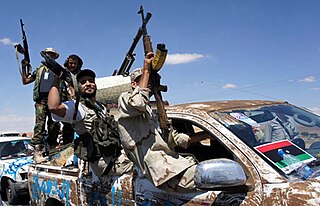
Benghazi is the second-most-populous city in Libya as well as the largest city in Cyrenaica, with an estimated population of 859,000 in 2023. Located on the Gulf of Sidra in the Mediterranean, Benghazi is also a major seaport.

Zliten is a city in Murqub District of Libya. It is located 160 km to the capital of Tripoli.

The Libyan Civil War began on 17 February 2011 as a civil protest and later evolved into a widespread uprising. By mid-August, anti-Gaddafi forces effectively supported by a NATO-led international coalition were ascendant in Tripolitania, breaking out of the restive Nafusa Mountains in the south to mount an offensive toward the coast and advancing from Misrata on loyalist-held cities and villages from the north and east.
Khamis Gaddafi was the seventh and youngest son of former Libyan leader Muammar Gaddafi, and the military commander in charge of the Khamis Brigade of the Libyan Army. He was part of his father's inner circle. During the First Libyan Civil War, he was a major target for rebel forces trying to overthrow his father.
Estimates of deaths in the 2011 Libyan vary with figures from 15,000 to 30,000 given between March 2 and October 2, 2011. An exact figure is hard to ascertain, partly due to a media clamp-down by the Libyan government. Some conservative estimates have been released. Some of the killing "may amount to crimes against humanity" according to the United Nations Security Council and as of March 2011, is under investigation by the International Criminal Court.
Free speech in the media during the Libyan civil war describes the ability of domestic and international media to report news inside Libya free from interference and censorship during the civil war.
The Battle of the Misrata frontline was a battle during the Libyan Civil War between pro-Gaddafi loyalists and anti-Gaddafi forces on the western and southwestern outskirts of Misrata, the third largest city in Libya. It ended when anti-Gaddafi soldiers secured Zliten to the west and Tawergha to the south, establishing a significant buffer zone around the city.
The Battle of Zliten followed an unsuccessful uprising in Zliten, Libya, during the Libyan Civil War. It began on 21 July 2011 when elements of the National Liberation Army, part of the anti-Gaddafi forces seeking to overthrow the government of Muammar Gaddafi, moved into the city of Zliten after struggling over the course of the past several months to extend the frontline westward from Misrata, the second-largest city in rebel hands.
The Zliten uprising was a local uprising in the Libyan Civil War, started by rebel anti-Gaddafi forces against loyalist pro-Gaddafi forces in the city of Zliten. The city was of strategic importance due to its close proximity to the capital of Tripoli. After Zliten, only two cities – Khoms and Tajura – separated the rebel stronghold of Misrata from Tripoli.

By the end of February 2011, medical supplies, fuel and food were dangerously low in Libya. On 25 February, the International Committee of the Red Cross launched an emergency appeal for US$6,400,000 to meet the emergency needs of people affected by the violent unrest in Libya. On 2 March, the ICRC's director general reminded everyone taking part in the violence that health workers must be allowed to do their jobs safely.

The Battle of Bani Walid was a military operation in the Libyan Civil War conducted by anti-Gaddafi forces in September and October 2011, in an effort to take control of the desert city of Bani Walid from pro-Gaddafi forces. It began following days of force buildup on the part of the attackers, as well as skirmishes around the city.

The 2011 Libyan Civil War began on 17 February 2011 as a civil protest and later evolved into a widespread uprising. After a military intervention led by France, the United Kingdom, and the United States on 19 March turned the tide of the conflict at the Second Battle of Benghazi, anti-Gaddafi forces regrouped and established control over Misrata and most of the Nafusa Mountains in Tripolitania and much of the eastern region of Cyrenaica. In mid-May, they finally broke an extended siege of Misrata.
This is a timeline of the 2011 military intervention in Libya. It covers all military action taken by NATO to implement United Nations Security Council Resolution 1973, beginning on 19 March 2011.
The 2012 Bani Walid uprising was an event which started on 23 January 2012 due to an incident in the city of Bani Walid in which the "May 28 Brigade" militia wished to arrest local men in unclear circumstances. The May 28 Brigade and their compound were then attacked by local fighters who then took control of the town. The incident, the combatants, and the motives of the two main belligerents — the May 28 Brigade and Brigade 93 — remain uncertain and contentious. The conflict was originally reported to be an attack by Gaddafi loyalists by local NTC officials. However, tribal leaders and residents have denied any affiliation with Gaddafi's remnants, stating their goal was the establishment of their own council in the city. Similarly Britain's Foreign Office has dismissed claims of this incident representing a pro-Gaddafi attack against the NTC, stating that this was a dispute between tribal leaders of the Warfalla tribe and the NTC.

Following the end of the First Libyan Civil War, which overthrew Muammar Gaddafi, there was violence involving various militias and the new state security forces. This violence has escalated into the Second Libyan Civil War (2014–2020).

Gaddafi loyalism, in a wider political and social sense also known as the Green resistance, consists of sympathetic sentiment towards the overthrown government of Muammar Gaddafi, who was killed in October 2011, and his Third International Theory. Despite Muammar Gaddafi's death, his legacy and Jamahiriya ideology still maintains a popular appeal both inside and outside Libya into the present day. Regardless, the Western sentiment has largely been that this continued support may contribute to some of the ongoing violence in Libya.

The Libya Shield Force is an armed organisation formed in 2012 out of anti-Gaddafi armed groups spread throughout Libya. The Libyan parliament designated much of the Libya Shield Force as terrorist and elements of the Libya Shield Force were identified as linked to al-Qaeda as early as 2012.
Mohamed Eshtewi was a Libyan politician who served as Mayor of Misurata from 2014 until 2017, when he was assassinated.
The 2020 Libyan protests consisted of street protests over issues of poor provision of services in several cities in Libya, including cities controlled by the Government of National Accord (GNA) in the west and by the Libyan National Army (LNA) in the east (Benghazi) and south (Sabha) of Libya.









